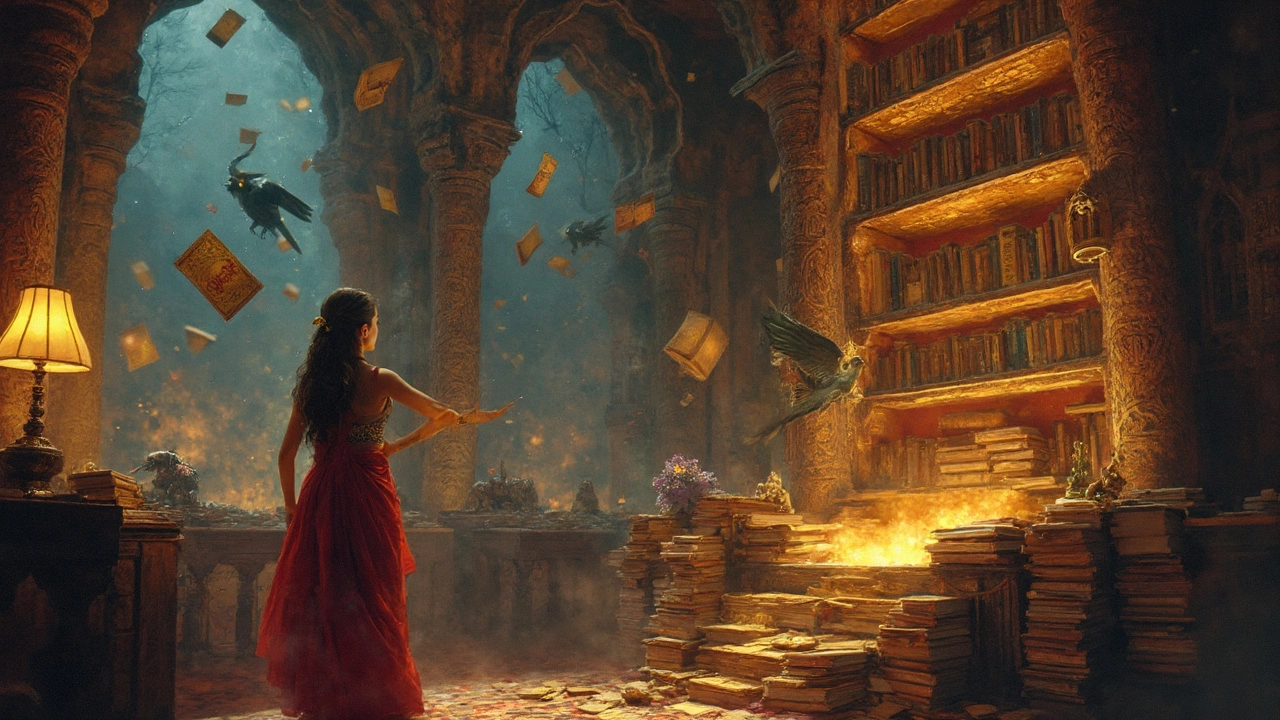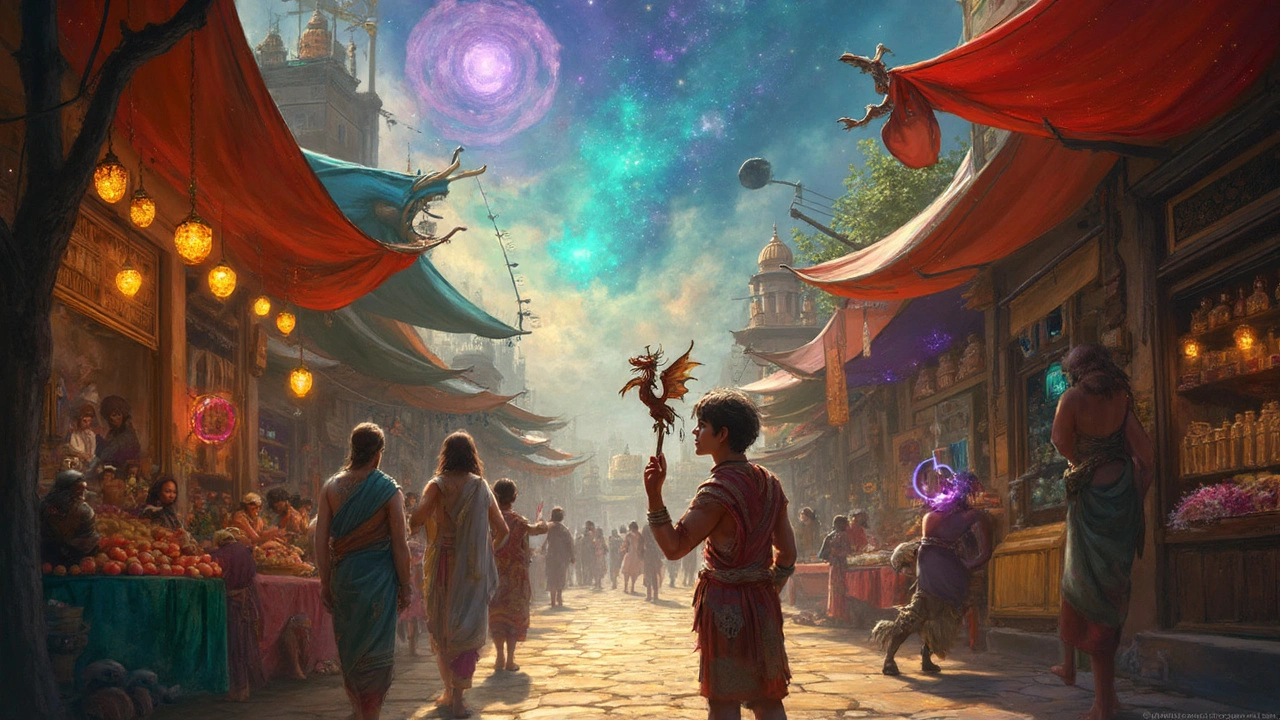Fantasy Book Definition: What Makes a Book a Fantasy Novel?

Dragons soar overhead. Wands shoot fire from fingertips. Whole worlds hide inside wardrobes and rattling train stations. Fantasy books have ruled my home since my daughter Thalia begged for Harry Potter at bedtime and my son Quentin ran around shouting, "You shall not pass!" But what exactly transforms a bunch of words on a page into a fantasy book? It’s way more than elves and weird spells. Fans and critics have been arguing about the details for years—sometimes with the kind of passion usually reserved for cricket finals or who last left Legos out on the floor. Some even say the line between fantasy and reality is blurry. But there's structure here, a kind of magic formula that really sets fantasy apart.
Core Ingredients That Make Up the Fantasy Genre
At its heart, a fantasy book is any story that builds its plot around things impossible in our world. We're talking magic systems, ancient curses, talking animals, and cities built on floating islands—all things that simply can’t occur under the laws of physics as we know them. J.R.R. Tolkien, often called the father of modern fantasy, coined the idea of a secondary world: a separate reality with its own rules. That’s why Middle-earth, Hogwarts, or even Narnia feel completely immersive. The rules of the story’s universe are different, and they’re not hidden or played off as science—no attempts to cloak a fireball in pseudo-physics. It has to be out-and-out fantastical.
But it’s not just about setting. The characters themselves are often not simply humans with a different address. Fantasy flings open the doors for elves, dwarves, orcs, dragons, faeries, shapeshifters, and all manner of beings impossible in a purely realistic tale. Their existence isn’t explained away with science, but with magic or ancient powers. You’ll often stumble across objects—rings, swords, stones—that do more than they should, thanks to enchantment or some old curse. These 'plot devices' are everywhere in fantasy, fueling quests and drama.
Let’s not forget the role of myth and legend. Good fantasy borrows heavy from older folklore and mythologies. Greek gods recycle as book characters. Celtic legends creep into forests of modern tales. Authors love to remix and twist these, sneaking in familiar creatures but giving them brand-new jobs and personalities.
World-building is the backbone. The more detailed, the better. A good fantasy novel outlines everything: history, cultures, languages, even strange politics and dietary habits. Think of George R. R. Martin’s 'A Song of Ice and Fire' series, where entire book forums exist just to unravel the Targaryen family tree.
But how does fantasy hold up against other genres that flirt with oddness? Science fiction also breaks reality, but usually explains its inventions with future tech or science gone mad. Magical realism slides a bit of the fantastical into everyday life but doesn’t build whole new worlds or have grand, sweeping quests.
Key Subgenres and Their Quirky Specialties
If you think fantasy is just knights, wizards, and fire-breathing lizards, think again. The genre branches into loads of twisting paths, each with a unique flavor—something for everyone from young kids to hard-edged adults with a dark sense of humor.
There’s high fantasy, which is what most people picture: entire worlds like Tolkien’s Middle-earth or Brandon Sanderson’s Roshar, detailed with invented cultures, languages, and species. The stakes are epic, sometimes involving the fate of whole continents. These tales lean heavy into the magic, the battles, and the sense that almost anything can happen.
Low fantasy, on the other hand, mashes the impossible together with the real world. Here, the story takes place in an Earth-like setting where magic sneaks in through where you least expect it—hidden wardrobes, subway tunnels, or under the local library. Think Neil Gaiman’s 'Neverwhere' or the magical mischief popping up in London’s shadow in 'Rivers of London.' The world feels familiar, but just off-kilter enough to keep you guessing.
Urban fantasy is set right inside noisy, recognizable cities. Wild magic tangles with city bureaucracy, and mythical creatures drive Ubers or pay rent on rundown flats. This subgenre boomed with authors like Charlaine Harris (of 'True Blood' fame) and Jim Butcher’s 'Dresden Files.'
Dark fantasy throws in a dash of horror, making the impossible genuinely dangerous or even terrifying. George R. R. Martin’s series treads here, mixing political intrigue with ice zombies and fire gods, while grimdark books ramp up the bleakness and moral murk.
Paranormal fantasy often runs alongside romance—think vampires, werewolves, or ghosts in our modern world. 'Twilight' and 'The Mortal Instruments' blend elements of fantasy and supernatural drama in school corridors and downtown lofts.
Fairy tale fantasy takes the oldest stories—think 'Cinderella' or 'Sleeping Beauty'—and twists them into new shapes. These retellings are everywhere, from Marissa Meyer’s 'Lunar Chronicles' sci-fi spins to Neil Gaiman’s darker takes.

How to Tell If Your Book is Actually Fantasy
Not every story with a hint of the strange belongs in the fantasy section. Here are some dead giveaways your book falls solidly into fantasy territory:
- The existence of magic is baked into the world's rules. Whether magic is hidden or wide out in the open, it needs to be an accepted, explained part of the setting—no scientific shadows or hand-waving.
- You find creatures or beings that cannot reasonably exist in this world, from talking dragons to beer-loving orcs.
- There are rules and boundaries to the magic or supernatural elements, even if they’re loose and mysterious. The fantasy isn’t random—there’s a system beneath the surface, even if it’s not totally explained to readers.
- The world-building stretches well beyond what you could pull off in historical fiction or drama. You’re dealing with maps, invented histories, and sometimes even languages.
- The conflict often revolves around magical forces, ancient prophecies, or epic journeys. Saving the world (or at least the local village) is usually somewhere on the to-do list.
Take 'The Lord of the Rings.' Magic, swords, elves, whole new languages. Compare that to something like 'Frankenstein'—which, while wild, is arguably more science fiction since the resurrection is explained with early 1800s “science.” Margaret Atwood once described how readers often mistake allegorical or speculative fiction for fantasy, but she says fantasy needs an “impossible” element—something no reasonable science could ever produce.
If you’re stumped, ask yourself: Would the story work the same way if you stripped out the magic or non-human creatures? If the answer is no, your book is probably fantasy. Try pitching the plot at a dinner party—if you get an eyebrow raised at words like 'necromancer,' 'pixie dust,' or 'ancient curse,' you’re probably describing fantasy fiction.
Fascinating Facts and How Fantasy Shapes Young Minds (and Old)
Now for a bit of fun: did you know that fantasy books consistently top bestseller lists worldwide? According to a 2023 Nielsen BookScan report, fantasy fiction sales in Australia jumped over 30% during the pandemic—folks needed dragon-fueled escapism more than ever. And it’s not just adults—kids lock onto fantasy early. A UK National Literacy Trust survey in 2022 found that 62% of children aged 8-12 listed a fantasy novel as their favorite book genre. My daughter nearly staged a revolution when they tried to swap out Harry Potter for non-fiction at her school library.
Parents often worry fantasy is just mindless escape, but researchers at the University of Sydney discovered in 2021 that reading fantasy stories helps children develop better empathy and complex reasoning skills. Immersing yourself in impossible worlds means you learn to look at the world from other angles. There’s power here—it plants seeds of creativity and resilience that stick with readers for life.
If you’re keen to write fantasy yourself, start with two basics: set up clear rules for your magic system (yes, even if they stay hidden most of the story) and build your world from the ground up. Even if most details never show on the surface, they’ll inform your story’s flavor. A quick tip—sketch your world's map. Readers adore being able to trace journeys or imagine the lay of the land. If you’re worried about tropes or clichés, read outside the fantasy section and weave in fresh ideas or perspectives from your own culture and experiences. A Sydney writer might imagine city ferries navigating misty rivers run by water spirits, or old tram tracks hiding doors to another age.
Here's a snapshot of popular fantasy elements and examples over the last few decades:
| Element | Example Book/Series | Year of First Publication |
|---|---|---|
| Complex Magic System | Mistborn (Brandon Sanderson) | 2006 |
| Invented Languages | The Lord of the Rings (J.R.R. Tolkien) | 1954 |
| Ancient Prophecy | Harry Potter Series (J.K. Rowling) | 1997–2007 |
| Non-human Races | Dungeons & Dragons/Dragonlance | 1978/1984 |
| Urban Magic | Neverwhere (Neil Gaiman) | 1996 |
The beauty of a fantasy book is that it serves as a gateway—sometimes an escape, sometimes a mirror held up to our own messy, flawed, amazing world. It lets everyone, from a bored office worker in Sydney to a restless kid in Tasmania, jump into new adventures with the flip of a single page. In the end, it's the impossible that makes fantasy possible—and that's real magic.
